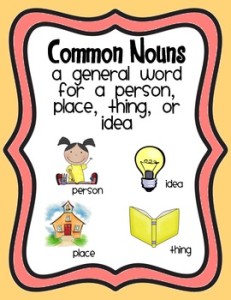English Grammar: Nouns, an Insight
We assume that anything that exists can be named.
These names are called nouns. Nouns can be either common nouns, which are general and non-specific, or proper nouns, which are specific. Both types of nouns can be people, places, things, or ideas.
For example, the following are examples of common nouns:
- People: Man, Woman, Detective, Chef
- Places: City, Country, Continent, Street (these can also be considered as “things”)
- Things: Computer, Ocean, Desert
- Ideas: Religion, Truth, Freedom, Slavery, Poverty, Wealth, Justice (these can also be considered as “things”)

Common Nouns are Persons, Places, Things, or Ideas
On the flip side, the following are examples of proper nouns:
- People: John, Jamie, Rose, Tyler
- Places: London, Mexico, Antarctica, Oxford Street
- Things: Dell Computer, Pacific Ocean, Sahara Desert
- Ideas: Catholicism, Scientology, Zionism, Fascism
Proper Nouns
Proper nouns can be thought of as unique nouns, since they refer to items which are unique and distinct from others. Proper nouns are usually capitalized as they name a specific person, place, thing, or idea. In general, common nouns are not capitalized.
For example:
“As it started to rain over Grove School, Sophie realized she had left her scarf and jacket in the car.”
“Grove School” is the specific name of the school, and “Sophie” is the specific name of a person, so these terms are capitalized as proper nouns. The following are common nouns found in the sentence: name, school, person, scarf, jacket, car.
There are some words which can function both as a proper and common noun. In these rare occasions, the type of noun must be determined from the context. For example, God is the name given specifically to the singular God monotheists believe in, where god refers to any one of many deities (e.g. in Norse mythology, Thor was the god of thunder and in Greek culture, Aphrodite was the goddess of love).
Subcategories of Nouns
There are other subcategories of nouns. These are: Countable/Uncountable, Collective, Concrete, Abstract, and Possessive.
Countable Nouns
Countable nouns are common nouns (or proper nouns) which can be pluralized. They combine with numbers or number words (including indefinite terms such as a few or several) and most commonly take the letter “s” to show plurality, although there are several exceptions to this. Examples of countable nouns are: elephants, books, flowers, saucepans.
Uncountable Nouns
Uncountable nouns are nouns which cannot be pluralized or combined with number words. They can only exist in their singular form. Examples of uncountable nouns are: geometry, furniture, indigestion.
Collective Nouns
Collective nouns are the names given to groups. The group is comprised of individuals but is grammatically treated like a single entity (for example: my family is and not my family are). Examples of collective nouns are: school, family, army, committee. It should be noted that in the United Kingdom, this rule does not always apply. For example, in UK they will say “the rock band are good”.
Concrete Nouns
Concrete nouns are classed by your ability to register the noun on one of your five senses. If you can see, smell, hear, taste, or touch the thing you’re trying to classify, it’s a concrete noun. Examples of concrete nouns are: clouds, perfume, music, salt, and water.
Abstract Nouns
Abstract nouns cannot be registered physically. They are ideas and concepts. Examples of abstract nouns are: happiness, sadness, anger, depression, love.
Possessive Nouns
The final type of noun is called possessive. These nouns name to whom or what something belongs, and is always a noun followed by another noun. Apostrophes are used to denote possession. Generally, apostrophe + “s” forms the possessive of singular nouns. It doesn’t matter if more than one thing is possessed. Examples of this are: Lucy’s coat, the kitten’s tail, London’s bridges.

Possessive Nouns in English Consist of Apostrophe + “s”
When a plural noun ends with an “s”, an apostrophe is used after the “s” to denote possession. Examples of this are: those merchants’ ships, the books’ pages.
When a plural noun does not end with an “s”, apostrophe + “s” is used to form the possessive. Examples of this are: the children’s shoes, the men’s drinks.
No comments yet.